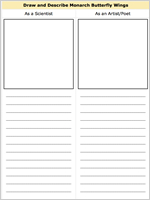Butterfly
Wings
Teaching Suggestions
Overview
Look closely at monarch butterfly wings with the eyes of a scientist, artist, and poet. Read to discover fascinating facts and use the activities below to help students explore:
|

After viewing photos and reading the text, students will be able to:
- Draw and label a scientific representation of monarch wings.
- Write a nonfiction paragraph that summarizes facts about monarch wings.
- Create an expressive drawing of monarch wings.
- Write descriptive sentences that expressively showcase monarch wings.
1. Observe and describe a monarch wing.
Show the magnified
photo of the monarch wing. Brainstorm
similes to describe details. Provide sentence starters to help students make comparisons:
- The brilliant orange color is like...(glowing embers).
- The shape is like...(fringed feathers).
- The scales overlap like...(layered shingles on a roof).
- Monarch wing scales look like...(soft flower petals).
2. Brainstorm words to capture sensory details.
Display images from the wings photo gallery. Distribute pre-writing attribute chart. Have students work with a partner to brainstorm sensory details to describe colors, shapes, sizes, textures, patterns, and distinctive features/markings.
3.
Collect facts about monarch wings.
Distribute text-only version. As you read through the text, underline descriptive words and phrases and then add them to the attribute chart.
4.
Write snapshot sentences.
Sentences that include sensory details that help a reader visualize ideas are called snapshot sentences. Explore how students can use words on their attribute charts to write snapshot sentences that describe monarch wings.
5.
Draw and describe monarch wings.
Use the draw and
describe handout to help students explore the science and art of monarch
butterfly wings:
- As
a scientist:
Challenge students to create a scientific illustration and written description of monarch wings. Remind students that a scientist's work is objective. A scientist would represent and describe the characteristics and features—patterns, size, textures, and colors—of the wings as accurately as possible.
- As
an artist/poet:
The goal of expressive drawing and writing is to capture the thoughts and feelings that are inspired by observations of nature. An artist's work is subjective. Challenge students to think about how an artist and poet would draw and describe a monarch butterfly to express the beauty and wonder of its wings. Spark creativity by encouraging students to capture how they feel when they observe monarchs.
Raul Gonzalez |






